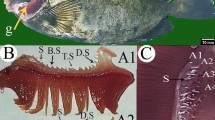Abstract
Natural food items of five species of marine cladocerans, Evadne nordmanni, E. tergestina, Penilia avirostris, Podon leuckarti and P. polyphemoides, were investigated in the Inland Sea of Japan between April 1986 and May 1987. Gut content examination with SEM (scanning electron microscopy) revealed that feeding was largely limited to centric diatoms and a few exceptions of pennate diatoms and dinoflagellates. No animal remains were detected, and some unidentified materials were also found. Phytoplankton smaller than 35 μm in size (cell diameter in centric diatoms and longest dimension in others) was found most frequently in the gut of cladocerans. The role of grazing of marine cladocerans in trophodynamic pathways of the pelagic realm is discussed.
Similar content being viewed by others
Literature cited
Bainbridge, V. (1958). Some observations on Evadne nordmanni Loven. J. mar. biol. Ass. U.K. 37: 349–370
Baker, H. M. (1938). Studies on the Cladocera of Monterey Bay. Proc. Calif. Acad. Sci. Ser. 4 23: 311–365
Bosch, H. F., Taylor, W. R. (1973). Distribution of the cladoceran Podon polyphemoides in the Chesapeake Bay. Mar. Biol. 19: 161–171
Conover, R. J. (1978). Transformation of organic matter. In: Kinne, O. (ed.) Marine ecology. Vol. IV. Dynamics. John Wiley & Sons, New York, p. 221–499
Della Croce, N., Venugopal, P. (1973). Penilia avirostris Dana in the Indian Ocean (Cladocera). Int. Rev. Gesamten Hydrobiol. 58: 713–721
Felgenhauer, B. E. (1987). Techniques for preparing crustaceans for scanning electron microscopy. J. Crust. Biol. 7: 71–76
Gieskes, W. W. C. (1971). Ecology of the Cladocera of the north Atlantic and the North Sea. Neth. J. Sea Res. 5: 342–376
Gore, M. A. (1980). Feeding experiments on Penilia avirostris Dana (Cladocera; Crustacea). J. Exp. Mar. Biol. Ecol. 44: 253–260
Jagger, R. A., Kimmerer, W. J., Jenkins, G. P. (1988). Food of the cladoceran Podon intermedius in a marine embayment. Mar. Ecol. Prog. Ser. 43: 245–250
Kim, S. W., Yoon, Y. H., Onbé, T., Endo, T. (in press). Is grazing of marine cladocerans important for the occurrence of red tide? In: Okaichi, T., Anderson, D. M., Nemoto, T. (eds.) Red tide: Biology, environmental science and toxicology. Elsevier, New York, p. 259–262
Lochhead, J. H. (1936). On the feeding mechanism of a ctenopod cladoceran, Penilia avirostris Dana. Proc. Zool. Soc. London “1936”: 335–355
Morey-Gaines, G. (1979). The ecological role of red tides in the Los Angeles-Long Beach Harbor food web. In: Taylor, D. L., Seliger, H. H. (eds.) Toxic dinoflagellate blooms. Elsevier, North Holland, p. 315–320
Nival, S., Ravera, S. (1979). Morphological study of the appendages of the marine cladoceran Evadne spinifera Müller by means of scanning electron microscope. J. Plankton Res. 1: 207–213
Onbé, T. (1974). Studies on the ecology of marine cladocerans. J. Fac. Fish. Anim. Husb. Hiroshima Univ. 13:83–179 (Japanese; English summary)
Onbé, T. (1977). The biology of marine cladocerans in a warm temperature water. Proc. Symp. Warm Water Zoopl. Spec. Publ. UNESCO/NIO (Goa), p. 383–398
Onbé, T. (1985). Seasonal fluctuations in the abundance of populations of marine cladocerans and their resting eggs in the Inland Sea of Japan. Mar. Biol. 87: 83–88
Paffenhöfer, G.-A., Orcutt, J. D. (1986). Feeding, growth and food conversion of the marine cladoceran Penilia avirostris. J. Plankton Res. 8: 741–754
Pavlova, E. V. (1959). On the feeding of Penilia avirostris. Tr. Sevastopol. Biol. Sta. 11: 63–71 (Engl. transl. Fish. Res. Bd Can. Transl. 967, 18p.)
Schram, F. R. (1986) Crustacea. Oxford University Press, New York
Sorokin, Y. I. (1973). Quantitative evaluation on the role of bacterioplankton in the biological productivity of tropical Pacific waters. In: Vinogradov, M. E. (ed.) Life activity of pelagic communities in the ocean tropics. Israel Program for Scientific Translations, Jerusalem, p. 98–134
Turner, J. T. (1984). The feeding ecology of some zooplankters that are important prey items of laval fish. NOAA Tech. Rep. Natl. Mar. Fish. Ser. 7: 1–28
Turner, J. T., Tester, P. A., Ferguson, R. L. (1988). The marine cladoceran Penilia avirostris and the “microbial loop” of pelagic food webs. Limnol. Oceanogr. 33: 245–255
Yoo, K. I., Kim, S. W. (1987). Seasonal distribution of marine cladocerans in Chinhae Bay, Korea. J. Oceanol. Soc. Korea 22: 80–86
White, A. W. (1980). Recurrence of kills of Atlantic herring (Clupea harengus harengus) caused by dinoflagellate toxins transferred through herbivorous zooplankton. Can. J. Fish. Aquat. Sci. 37: 2262–2265
Author information
Authors and Affiliations
Additional information
Communicated by M. Anraku, Tokyo
Rights and permissions
About this article
Cite this article
Kim, S.W., Onbé, T. & Yoon, Y.H. Feeding habits of marine cladocerans in the Inland Sea of Japan. Mar. Biol. 100, 313–318 (1989). https://doi.org/10.1007/BF00391145
Accepted:
Issue Date:
DOI: https://doi.org/10.1007/BF00391145




